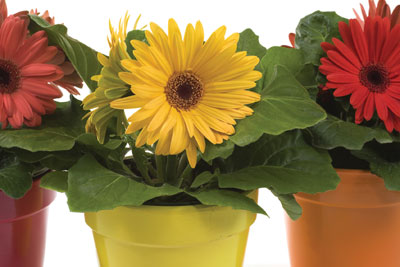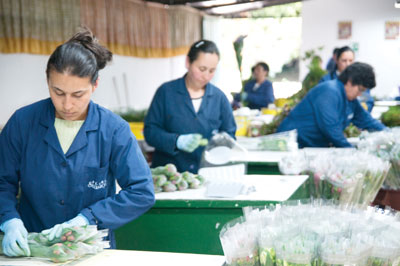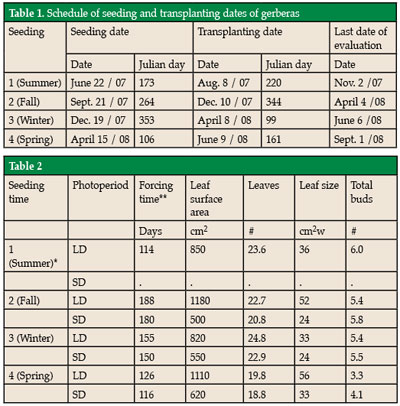
Features
Lighting
Structures & Equipment
Light touch with gerbera
December 29, 2010 By Dr. Theo J. Blom
Introduction: Potted flowering gerbera, generally marketed from April to October, have become popular potted plants in Ontario. Understanding the effect of both light sum and photoperiod on the flower initiation and plant morphology is important when growing potted gerbera for different markets. For small-sized potted gerbera (10-cm pots), early flowering, short flower scape (flower stem) and small leaves are important, while for larger sized pots (15-cm diameter), plants must be larger and may need a longer flower scape to provide proper proportion.
Introduction: Potted flowering gerbera, generally marketed from
April to October, have become popular potted plants in Ontario.
Understanding the effect of both light sum and photoperiod on the
flower initiation and plant morphology is important when growing potted
gerbera for different markets. For small-sized potted gerbera (10-cm
pots), early flowering, short flower scape (flower stem) and small
leaves are important, while for larger sized pots (15-cm diameter),
plants must be larger and may need a longer flower scape to provide
proper proportion.

|
| The greatest effect of potted gerbera photoperiod was not on flowering, but rather on plant size. (photo courtesy dr. Theo Blom) Advertisement
|
Many growers who grow potted gerbera rely on natural daylength to
schedule flowering. About six to seven years ago, our research with cut
gerbera showed that flowering and scape length were strongly affected
by photoperiod.
Discussion of the flowering response of potted gerbera to photoperiod
arose when growers began to use HPS lighting for increasing daily light
sum to extend the marketing season. If potted gerberas are short-day
responsive plants, then it is pertinent to know how many hours the
supplemental lights can operate beyond the natural photoperiod.
The objectives of this study were: (i) to determine whether potted
gerbera are responsive to photoperiod both in terms of flowering and
plant shape; and (ii) to determine whether the daily light sum affects
the time required to flower.

|
| Figure 1. The effect of photoperiod (SD is short-day; LD is long-day) on plant size of potted gerbera in 15-cm diameter pots. Note – the number of flowers on the LD and SD plant may not be representative of the treatment! Plants were seeded on Sept. 21, 2007.
|
MATERIALS AND METHODS
Seeds of various gerbera suppliers/series (S&G Flowers/Jaguar,
three cv’s; Sakata/Festival, two cv’s; Samurai, two standard cv’s and
one mini cv; and Green Circle/Revolution, two cv’s) were seeded in 288
plug trays and germinated in a germination chamber set at 25ºC and
12-hour photoperiod. Seeding took place on four different dates,
corresponding to the beginning of each season: summer, fall, winter and
spring (Table 1).

|
After germination, the seedlings were moved to a glass greenhouse with
a misting chamber (a plastic tent, equipped with misting system, within
the greenhouse) until the seedlings reached the five- to eight-leaf
stage. Then, the seedlings were transplanted singly into either a 10-cm
or a 15-cm diameter plastic pot filled with a soilless substrate
(Sunshine #4, Sun-Gro).
After one week under ambient light conditions, the pots were then moved
to a glass greenhouse maintained at 20ºC minimum temperature. The
greenhouse had four benches, each with an automatic blackout system
that was closed from 5 p.m. until 8 a.m. daily so that the plants on
all benches received a similar natural daily light sum. Two benches
were provided with a four-hour night interruption using compact
fluorescent lamps (1µmol / m2/s or 65 lux) from 10 p.m. to 2 a.m. daily
to create a long-day photoperiod (LD), while the other two benches were
considered short-day (nine-hour) photoperiod (SD). Each bench had 10
pots per cultivar and per pot size. Plants were sub-irrigated with a
solution of Plant Products 20-8-20 at 250 ppm nitrogen and occasionally
the plants in 10-cm pots were watered by hand as they required more
frequent irrigations than the plants in 15-cm pots.
When plants had two to three open blooms (considered to be a marketable
stage), the following data were collected on a per plant basis: date of
flowering, number of juvenile (round) and mature leaves (leaves formed
after transplanting), and the leaf area of the mature leaves. The
number of open flowers and green buds was recorded as well.
RESULTS: Due to the malfunction of one of the blackout systems,
the results of the first seeding were combined for the SD and LD
periods (summer). For the second, third and fourth seeding, the overall
mean of all cultivars is presented for both SD and LD regimes (Table 2).
Table 2. The overall mean of forcing time, leaf surface area, number of
“mature” leaves and individual leaf size and number of flower buds for
all gerbera cultivars for the different seeding dates and photoperiod
treatment starting after transplanting.
* The data for SD and LD were combined due to a malfunction of the blackout system.
** The forcing time is calculated from seeding date to flowering date for all cultivars.
Seedings done in the summer and spring showed the shortest forcing
period (about 114-126 days), followed by winter seeding (153 days) and
then fall seeding (184 days). Gerbera flowered under either photoperiod
regime, but LD delayed the flowering consistently by about five to10
days. This makes gerberas a facultative short-day (SD) plant. The
number of flower buds was also slightly increased by the SD regime
(Table 2).
Interestingly, the total leaf area of the plant under LD regime was 50
to 100 per cent larger than under short days, while the number of
leaves under the LD regime only increased by about five to 10 per cent
(one to two leaves). This resulted in individual leaves that were
significantly larger under LD compared to SD regime. While gerbera
grown in larger pots (15-cm diameter) flowered consistently earlier
(three to four days), the leaf area was about 35 per cent greater
compared with plants grown in 10-cm pots (data not shown). Although
this report was not focused on determining the effects of a specific
series, the Jaguar series flowered earlier than the other series and
also had the smallest plant size (data not shown).
DISCUSSION/CONCLUSIONS
Flowering response: Potted gerberas grown under short-day photoperiods
consistently flowered one week earlier than under the long-day
photoperiod. The earlier flowering represented only a five per cent
decrease in the total forcing time. The slightly lower number of leaves
under the short-day photoperiod (about one leaf) supported this result.
In this trial, the LD regime produced 22.4 mature leaves (mean of three
seasons, two pot sizes and cultivars; n=180 pots), while the SD regime
had 20.8 leaves at flowering. Seasonal differences in forcing time due
to daily light sum are much greater than those caused by the
photoperiod. The total period of forcing varied between six months
(September seeding) and four months (March or June seeding). It is
estimated that under our conditions, the September seeding received a
total light sum of about 750 mol/m2 while the March seeding received
about 1600 mol / m2. Flowering of gerbera is thus light sum dependent.
Strangely, the number of leaves between the seasons did not vary much.
From our results, it can be concluded that potted gerbera are
facultative short-day plants, but are strongly dependent on the daily
light sum.
Plant size: The greatest effect of photoperiod was not on flowering
but rather on plant size. Total leaf area under LD regime was 60-65 per
cent greater than under the SD regime. Because the number of leaves
varied very little between the LD and SD photoperiods, it can be
concluded that individual leaf size was also about 60 per cent larger
under LD compared to SD. Pot size also affected plant size (data not
shown) as plants grown in 15-cm diameter pots were 35 per cent larger
(leaf surface area) compared to 10-cm pots. This was consistent for all
seasons, although the September seeding showed the greatest effect.
Thus, if one requires a larger plant for a 15-cm diameter pot, then one
may consider a LD regime; but if a smaller plant is required (10-cm
diameter pot), then a SD regime may be more suitable.
Dr. Theo J. Blom is a professor in the Department of Plant Agriculture at the University of Guelph.
Print this page